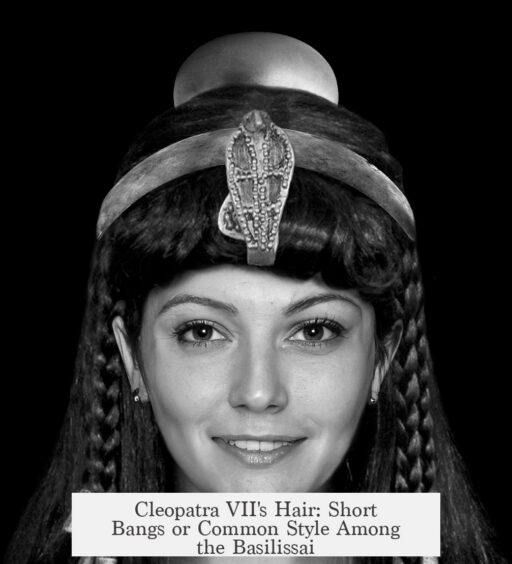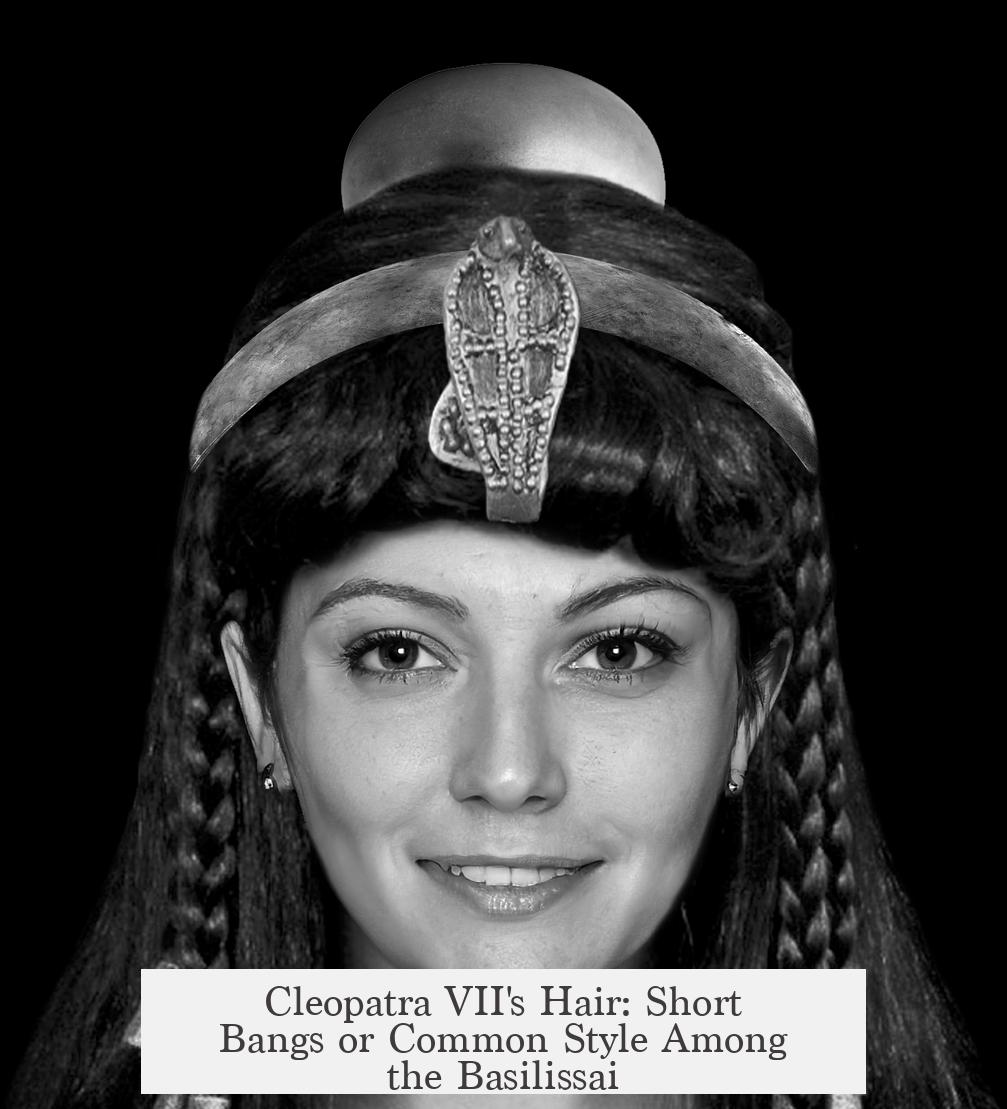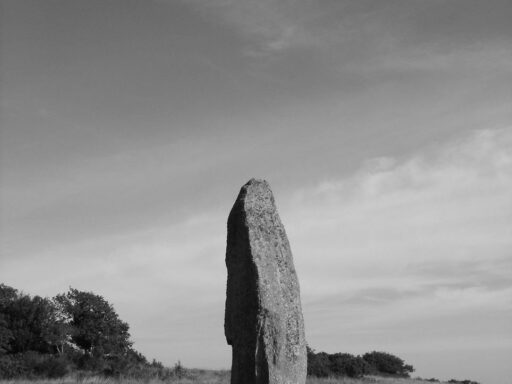Cleopatra VII did not historically cut her hair short at the forehead, and the famous “Cleopatra bangs” style is a modern invention rather than an ancient tradition among the Basilissai or Ptolemaic queens. Ancient depictions consistently show Cleopatra wearing pulled-back hairstyles, notably the melon coiffure, rather than short-cut bangs. The popular image of Cleopatra with bangs originates from 20th-century cinema and popular culture, not from historical or archaeological evidence.
Cleopatra VII’s authentic hairstyle is best documented through archaeological and numismatic sources like statues, busts, and coins. The most iconic and historically attested style is the melon coiffure. This involves braids or rows of hair pulled backward, creating a rounded bun at the back of the head. The bun’s ridged appearance resembles a melon, which is how the style gets its name. This coiffure often appears alongside corkscrew curls framing the face, especially around the ears and forehead.
Several key artifacts illustrate this style. The Vatican portrait of Cleopatra prominently displays the melon coiffure. Similarly, the Berlin portrait shows a simpler variant with wavy curls drawn back into a bun, bordered with corkscrew curls around the forehead. Numerous coins from Cleopatra’s reign, including silver 80 drachm denomination coins, depict the queen with this coiffure or variants closely resembling it.
The melon coiffure holds deeper significance beyond mere fashion. It connects Cleopatra with divine figures, most notably the Greek goddess Aphrodite and the Egyptian goddess Isis. This association fit Ptolemaic queens’ goals to position themselves as both Hellenistic and Egyptian divine rulers. Cleopatra’s adoption of this style aligns her with those religious and cultural ideologies, reinforcing her power and identity.
Importantly, this hairstyle was not unique to Cleopatra. Other Hellenistic and Ptolemaic women also wore variations of the melon coiffure. For example, coins and busts depict Ptolemaic queens such as Arsinöe II wearing similar hairstyles. A gem cameo of Berenike II further demonstrates this style’s prevalence among elite women of the era. This shows the melon coiffure was a broader cultural norm among the Basilissai, not an individual innovation.
Moreover, the style influenced Roman aristocratic women from about the mid-1st century BCE. Historians note an increase in Roman portraits of aristocratic women adopting hairstyles derived from or inspired by Cleopatra’s coiffure. This highlights her style’s cultural impact beyond Egypt and Greece.
Contrastingly, the now-legendary “Cleopatra bangs”—hair cut short and straight across at the forehead—do not appear in any ancient images or textual descriptions of Cleopatra. Traditional historical and archaeological depictions never show her with hair cut this way. Her hair consistently appears styled as rows or braids pulled back, without short-cut bangs.
Some Egyptian statuaries inspired by local traditions display hair arrangements that may resemble bangs or fringe-like styles. However, these are very different from modern “Cleopatra bangs” and do not imply that Cleopatra herself or other Ptolemaic queens cut their hair short at the forehead.
The modern conception of Cleopatra with bangs stems from early 20th-century popular culture, especially cinema. A 1912 film starring Theda Bara portrayed Cleopatra with a shoulder-length cut featuring straightened bangs, which was not historically accurate but visually striking. Later movies reinforced this image. In 1934, Claudette Colbert’s portrayal further spread this look. Elizabeth Taylor’s 1963 portrayal of Cleopatra firmly cemented the bangs as the queen’s cinematic trademark. Thus, the “Cleopatra bangs” represent a stylistic choice by filmmakers rather than a historical reality.
| Aspect | Historical Reality | Modern Depiction |
|---|---|---|
| Forehead Haircut (Bangs) | Absent in ancient depictions | Popularized in 20th-century films |
| Main Hairstyle | Melon coiffure with rows/braids pulled back into bun | Often omitted or altered for cinematic aesthetics |
| Usage Among Basilissai | Common melon-style among Ptolemaic queens | N/A |
| Symbolism | Linked to Aphrodite and Isis divine imagery | Usually ignored |
In essence, the short bangs associated with Cleopatra today are a product of modern film and media, not the actual fashion of Ptolemaic queens. Instead, Cleopatra VII’s hairstyle reflects a deliberate cultural and religious identity strategy, expressed through the melon coiffure that many elite women shared. This style promoted her divine affiliations and royal status.
- Cleopatra VII’s authentic hairstyle was the melon coiffure, not short bangs.
- Melon coiffure features braids pulled back into a bun with curls framing the face.
- The style was common among earlier Ptolemaic queens and reflected divine symbolism.
- There is no ancient evidence Cleopatra cut her hair short at the forehead.
- The “Cleopatra bangs” originated in early 20th-century films, not from history.
- Modern portrayals emphasize bangs for dramatic effect, diverging from historical accuracy.
Did Cleopatra VII always cut her hair short at the forehead? Was it natural among the Basilissai? If not, where did this depiction come from?
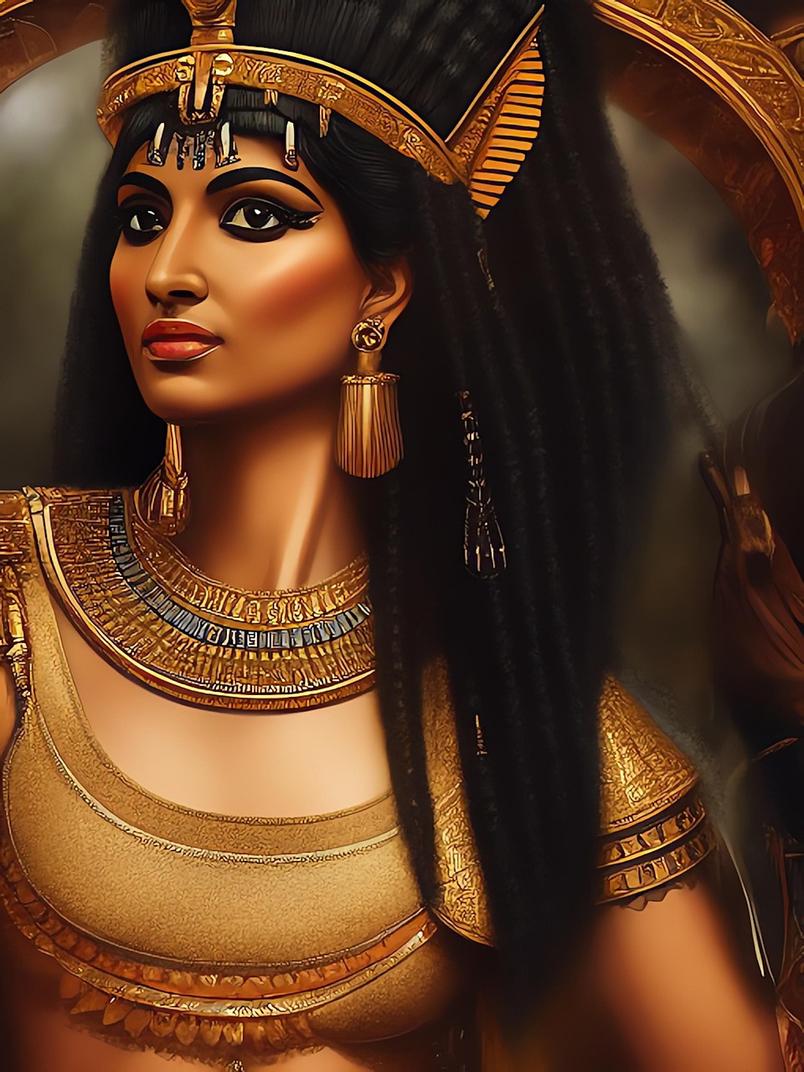
Cleopatra VII did not always cut her hair short at the forehead. In fact, the iconic “Cleopatra bangs” hairstyle is a modern invention, popularized by early 20th-century films rather than ancient depictions. Historically, Cleopatra’s recognized hairstyle is the “melon coiffure,” an elaborate braided look pulled back into a bun with curls around the forehead and ears.
Curious why the idea of Cleopatra’s short bangs has such staying power? Let’s unpack the origins, the reality, and the fascinating hairstyles of the queen and her elite peers.
The Melon Coiffure: Cleopatra’s Authentic Hair Statement
Imagine Cleopatra’s hair styled not with blunt cuts but with delicate rows of braids or twists, pulled elegantly back from the forehead into a bun. This “melon coiffure” draws its name from its visual similarity to the ridged surface of a melon. Instead of bangs, our famous queen’s hair gathered and curled around her face, showing off corkscrew curls framing her ears and forehead.
This hairstyle appears on numerous statues and coins. For example, the Vatican and Berlin portraits of Cleopatra showcase these twisted rows meticulously arranged. Roman silver coins—the type used daily—highlight her style with slight variations of the melon coiffure, underscoring its popularity as a royal mark.
But it wasn’t just about looks. Cleopatra’s hairstyle linked her to goddesses like Aphrodite and Isis. These divine connections were no accident; they helped cement her image not only as a ruler but as a living deity, merging beauty with power in the eyes of her subjects.
Was the Melon Coiffure Common Among the Basilissai?
Cleopatra’s melon coiffure was far from unique in her time. Many other royal women of the Ptolemaic dynasty and Hellenistic courts sported it or close variations. Coins featuring Arsinöe II and gem cameos of Berenike II provide clear evidence of this shared style among Ptolemaic queens.
The tradition even carried over into Roman portraiture by the mid-1st century BCE. Roman aristocratic women began adopting this style, often inspired by or in homage to Cleopatra’s prominence in Rome during 46-44 BCE. It was a trendsetter look, influencing high society far beyond Egypt’s borders.
So, What About Those Cleopatra Bangs?
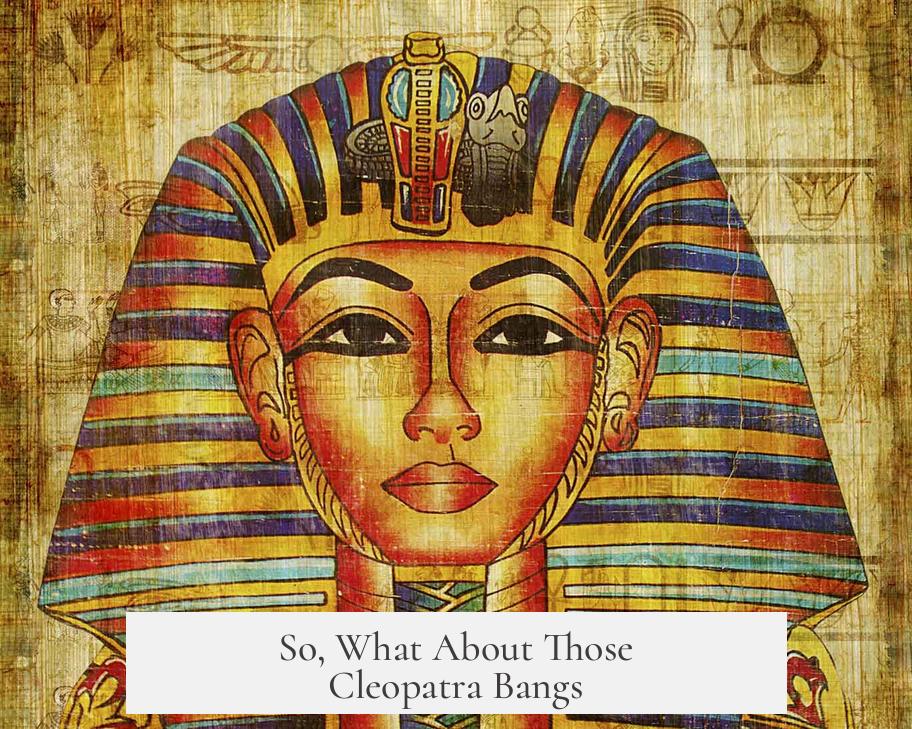
If Cleopatra’s authentic hairstyle avoided short hair at the forehead, where does the popular image of “Cleopatra bangs” come from? This is an invention born of early 20th-century pop culture, not the classical world.
Films like the 1912 production starring Theda Bara introduced the idea of Cleopatra with shoulder-length hair and a straight fringe. Later movies, including the 1934 “Cleopatra” with Claudette Colbert, reinforced this look. The modern iconic image of Cleopatra—Elizabeth Taylor’s 1963 portrayal with sharp, short bangs—cemented this style in global imagination.
Actual ancient depictions do not support this. The melon coiffure and its versions dominate statues, reliefs, and coins but none show Cleopatra with the pronounced short bangs or fringe that we now associate with her.
Could Egyptian-Style Statuary Be to Blame for the Bangs Myth?
Some Egyptian-inspired statues show Ptolemaic queens with more fringe-like hairstyles, but these differ significantly from the Hollywood Cleopatra bangs. For example, a famous statue with hair loosely arranged and not pulled into a bun may look bang-like to modern eyes but this does not equate to cutting hair short across the forehead.
These styles reflect a fusion of Egyptian and Greek influences, natural for Ptolemaic rulers who embraced both cultures. Still, they were different from the neat, straight-across bangs created by scissors centuries later.
Why Does This Matter?
Understanding the true hairstyle of Cleopatra VII destroys a common myth but also opens a window into Hellenistic royal fashion and propaganda. It emphasizes how rulers crafted their images not only with politics but with symbolic beauty. The melon coiffure speaks to status, divinity, and cultural syncretism, rather than simply a haircut trend.
It also reminds us how pop culture shapes historical perceptions, sometimes bending facts for dramatics. If you’re designing a costume or writing about Cleopatra, consider reaching for the melon coiffure and braided buns instead of the bangs. Those curls and rows tell a richer story.
A Quick Recap in Brief
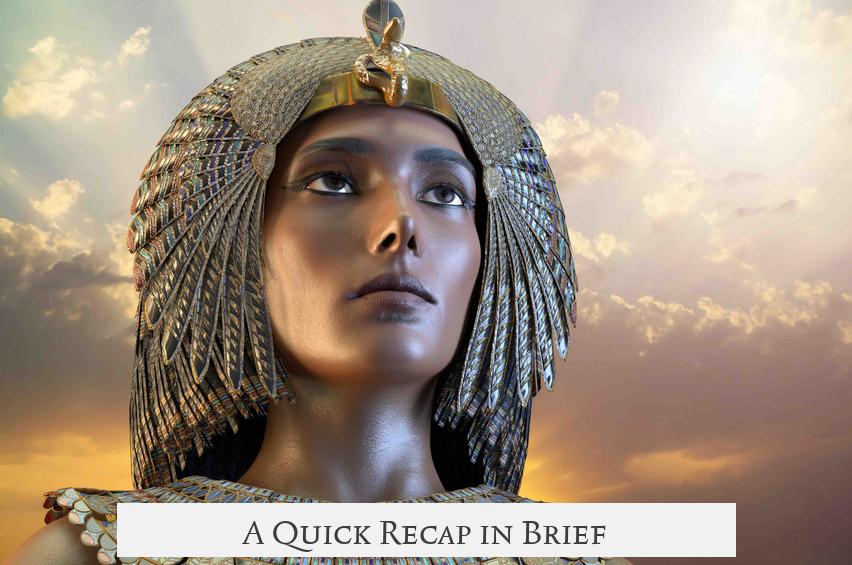
- Cleopatra’s authentic hairstyle: The melon coiffure, rows of braids pulled back into a bun.
- Divine symbolism: Hairstyle linked to goddesses Aphrodite and Isis.
- Widespread among Basilissai: Popular with other Ptolemaic queens and Roman elites.
- Cleopatra bangs: A modern Hollywood invention, starting in the early 1900s and popularized by Elizabeth Taylor.
- Egyptian statues: Show bangs-like styles but don’t represent short forehead cuts.
Final Thought
So, did Cleopatra chop her hair into a sharp fringe? No. But she definitely knew how to rock the “melon coiffure” like a queen. That hairstyle wasn’t just fashion—it was power, religion, and identity wrapped into one beautiful look. And that’s a style worth remembering.
